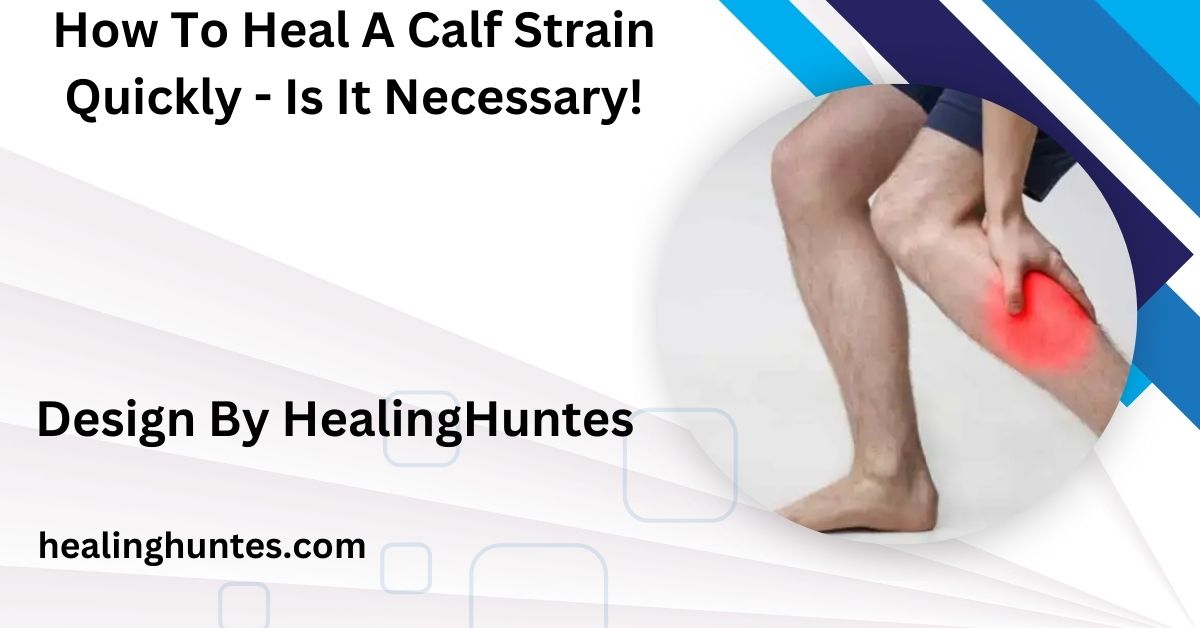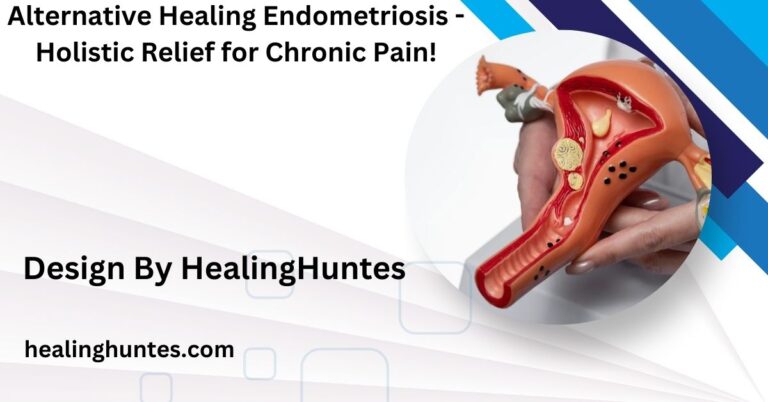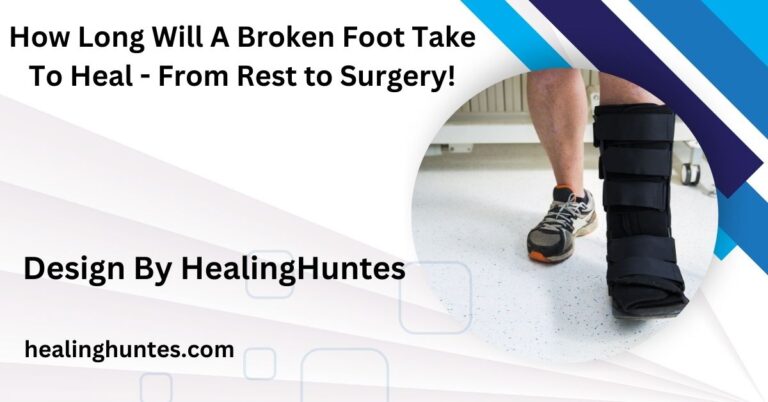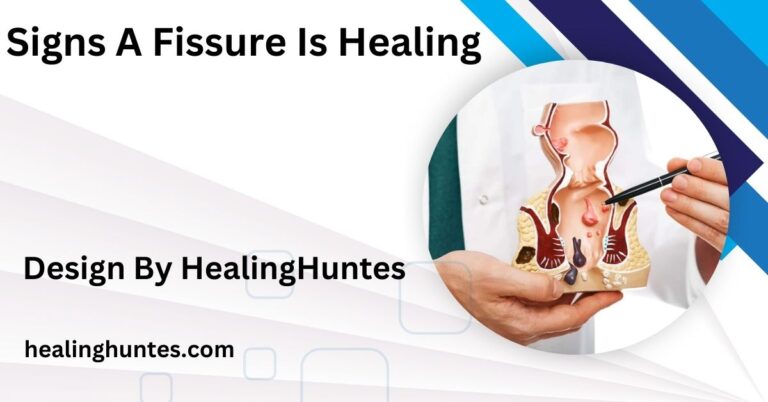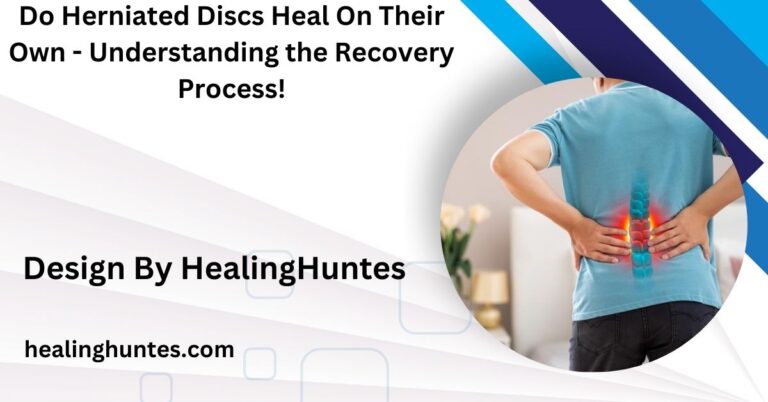How To Heal A Calf Strain Quickly – Is It Necessary!
Healing a calf strain quickly requires a combination of rest, controlled exercises, and targeted therapies to promote effective recovery.
This guide provides effective strategies, from initial care to advanced treatments, to speed up recovery and get you back on your feet.
Understanding a Calf Strain:

A calf strain involves partial tearing of muscle fibers in the calf. It generally affects two muscles: the gastrocnemius and the soleus. Symptoms include sudden pain, swelling, stiffness, and limited movement, making walking and activities difficult. Recognizing the severity of your strain helps tailor treatment to speed up recovery. There are three grades of calf strain:
- Grade 1: Minor strain with minimal discomfort and little to no swelling.
- Grade 2: Moderate strain involving more muscle fibers, causing moderate pain and swelling.
- Grade 3: Severe strain where the muscle is fully torn, leading to intense pain, swelling, and often, inability to walk.
Properly addressing each grade with the right treatment is essential to avoid prolonged recovery times or re-injury.
Initial Steps for Immediate Relief:
To achieve immediate relief from a calf strain, prioritize rest and limit physical activity to prevent further injury. Apply ice to the affected area for 15-20 minutes every hour to reduce swelling and alleviate pain, and use a compression bandage to support the muscle. Additionally, keep the leg elevated above heart level to minimize swelling and promote healing.
Also Read: Signs Herniated Disc Is Healing – Key Indicators!
Rest and Limit Activity:
Rest is crucial in the first 48 hours to prevent further strain. Avoid putting weight on the injured leg and use crutches if necessary. The aim is to give the muscle time to begin healing.
Apply Ice for Swelling and Pain:
Applying ice to the calf helps reduce swelling and pain. Place a cloth over the skin before using an ice pack, and apply it for 15-20 minutes every hour for the first day. Continue icing a few times daily for the next 2-3 days.
Compression to Support the Muscle:
Using a compression bandage can help control swelling and provide additional support to the injured muscle. Make sure the bandage is snug but not too tight, as restricting blood flow can worsen the injury.
Elevate the Leg:
Elevate your leg above heart level whenever possible to decrease swelling. This position promotes blood flow away from the injured area and can help reduce inflammation.
Gradual Introduction of Movement:
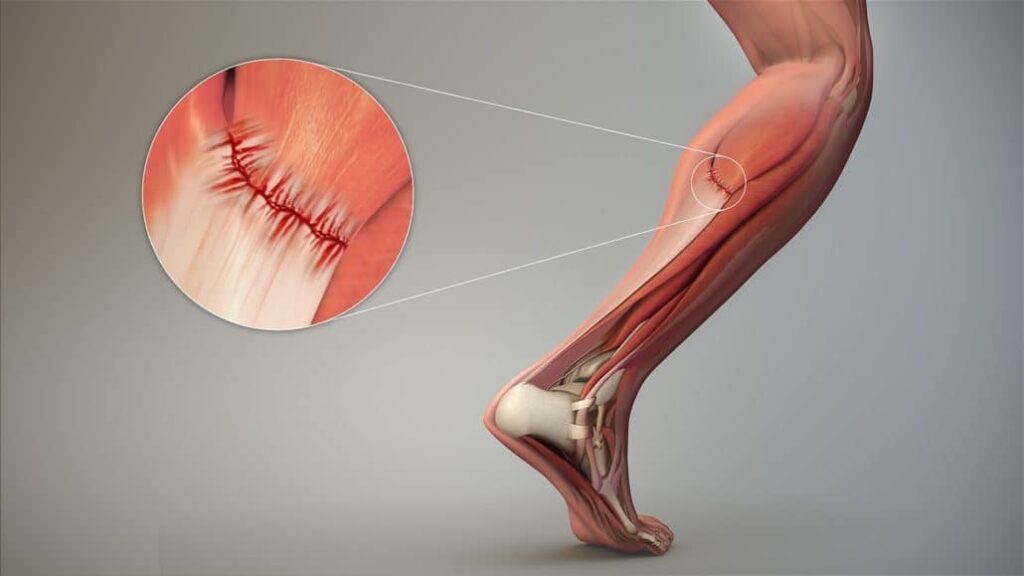
Once the initial swelling subsides, gradually reintroduce movement to prevent stiffness and promote healing. Start with gentle stretching and range-of-motion exercises, ensuring that movements are pain-free and comfortable. As you gain strength, incorporate low-resistance calf exercises to rebuild muscle function without risking re-injury.
Light Stretching and Range-of-Motion Exercises:
After 3-5 days of rest, start gentle stretching to regain flexibility. Light stretches, such as pointing and flexing the foot, can reduce stiffness without aggravating the strain. Ensure each stretch is gradual and pain-free.
Strengthening Exercises:
Once stretching is comfortable, incorporate calf-strengthening exercises. Try toe raises or gentle calf raises to rebuild muscle strength. Aim for low-resistance, high-repetition exercises initially to avoid straining the healing muscle further.
Incorporating Mobility Work:
Mobility exercises enhance blood flow and prevent scar tissue buildup. Gentle massage of the calf can help reduce muscle tension, improve circulation, and speed up healing.
Also Read: Signs Your Liver Is Healing – Recognize Liver Recovery!
Advanced Recovery Techniques:
Advanced recovery techniques like physical therapy, heat therapy, and electrotherapy can enhance healing and relieve calf strain discomfort. Physical therapy provides personalized exercises to strengthen and improve mobility, while heat and electrotherapy promote blood flow and reduce muscle tension. These treatments, combined with rest and gradual movement, support faster, more effective recovery.
Physical Therapy:
A physical therapist can design a program tailored to your injury level and recovery progress. Therapists may use therapeutic ultrasound, massage, and specific exercises to strengthen and restore muscle function.
Heat Therapy for Muscle Relaxation:
Heat therapy can help after the initial swelling stage, typically after 72 hours. Heat increases blood flow, promoting healing and reducing tightness. Use warm compresses for about 15 minutes a few times daily to relax the muscle.
Electrotherapy:
Electrotherapy involves using electrical currents to reduce pain and improve circulation. Techniques such as TENS (transcutaneous electrical nerve stimulation) can help manage discomfort and promote blood flow, aiding in faster recovery.
Massage Therapy:
Massage can increase circulation, release tension, and improve flexibility. Gentle calf massages promote healing by breaking down scar tissue and preventing stiffness. Always consult a professional therapist to avoid worsening the injury.
Nutrition and Hydration for Optimal Healing:

Proper nutrition and hydration are essential for muscle recovery and inflammation reduction. Prioritize protein-rich foods for muscle repair, anti-inflammatory options like leafy greens and omega-3s, and drink plenty of water daily. Avoid processed foods that can increase inflammation and slow healing.
Protein for Muscle Repair:
Protein is essential for tissue repair. Incorporate lean meats, fish, dairy, and plant-based proteins like beans and tofu into your diet to provide the body with amino acids for muscle regeneration.
Anti-Inflammatory Foods:
Omega-3 fatty acids found in fish, nuts, and seeds, along with antioxidant-rich fruits and vegetables, help reduce inflammation. Avoid processed foods, as they can increase inflammation and slow recovery.
Stay Hydrated:
Hydration supports nutrient transport and flushes out toxins. Drink at least 8 glasses of water daily to keep muscles hydrated, aiding in the repair process.
Preventing Future Calf Strains:
To prevent future calf strains, incorporate a proper warm-up and dynamic stretching routine before any activity, focusing on flexibility and blood flow to the muscles. Strengthen the calves along with supporting muscles like the hamstrings and glutes to improve stability. Gradually increase exercise intensity, allowing your muscles to adapt and minimize strain risk.
Also Read: How To Heal Cavities In 2 Days – Cavity Healing Tips!
Warm Up and Stretch:
A proper warm-up increases blood flow to muscles and prepares them for activity. Dynamic stretches like leg swings or light jogging reduce injury risk by loosening muscles.
Strengthen Supporting Muscles:
Incorporate exercises that target surrounding muscles like hamstrings and glutes. Strong supporting muscles improve stability, reducing calf strain risks.
Gradually Increase Intensity:
Avoid sudden increases in exercise intensity. Gradually build strength and endurance to allow your muscles to adapt to higher demands.
When to Seek Medical Help:
Seek medical help if you experience severe or persistent pain, significant swelling, or difficulty bearing weight, as these could indicate a more serious injury. Visible bruising or intense discomfort that doesn’t improve with rest may require a professional evaluation. A healthcare provider can assess the injury and recommend appropriate treatment or imaging if needed.
Persistent or Intense Pain:
If pain is severe or lasts beyond a few days despite treatment, consult a healthcare professional. They may order imaging tests like MRI or ultrasound to determine the extent of the injury.
Inability to Bear Weight:
If walking or bearing weight becomes impossible, it may indicate a severe strain or rupture. A doctor can provide a comprehensive diagnosis and suggest suitable treatment options.
Visible Bruising and Swelling:
Significant bruising or swelling could indicate a more serious injury. Medical evaluation can ensure you’re on the right treatment path for recovery.
FAQ’s
1. How long does it take to recover from a calf strain?
Mild strains heal in 1-2 weeks, moderate in 4-6 weeks, and severe strains may take several months.
2. Can I walk on a strained calf muscle?
It’s best to avoid weight-bearing for a few days to prevent further injury.
3. When should I use ice vs. heat on my calf strain?
Use ice for the first 48-72 hours; switch to heat after swelling subsides.
4. Are there specific exercises I can do to recover faster?
Yes, start with gentle stretches, then progress to strengthening exercises.
5. What should I eat to speed up calf strain recovery?
Focus on protein-rich, anti-inflammatory foods to support healing.
Conclusion
Healing a calf strain quickly requires a balance of rest, controlled movement, and targeted therapies. By following these guidelines, you can speed up the recovery process, reduce discomfort, and return to your regular activities. Remember to listen to your body throughout recovery, avoiding activities that may worsen the injury. With time, patience, and the right approach, you can heal fully and reduce the risk of future strains.
